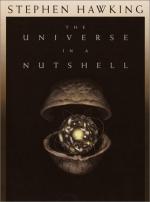
|
| Name: _________________________ | Period: ___________________ |
This test consists of 15 multiple choice questions and 5 short answer questions.
Multiple Choice Questions
1. How does Hawking state particle states be represented?
(a) With light functions.
(b) With wave functions.
(c) With satellite functions.
(d) With bell curves.
2. What will create great problems for unimproved humans?
(a) Molecular physics.
(b) Genetic engineering.
(c) Moralistic contrivances.
(d) Genetic malfunctions.
3. What is the name of Hawking's conjecture about the laws of physics and macroscopic time travel?
(a) The Chronological Spacetime Conjecture.
(b) The Chronology Protection Conjecture.
(c) The Timeline Protection Conjecture.
(d) The Theoretical Projection Conjecture.
4. What laws might allow space-time to warp to allow a spaceship to travel through the past?
(a) The laws of calculus.
(b) The laws of aerodynamics.
(c) The laws of geometry.
(d) The laws of physics.
5. What does Hawking compare to brains in the complexity versus speed trade-off?
(a) Electronic circuits.
(b) Underground wires.
(c) Sonic waves.
(d) Malfunctioning circuit boards.
6. What would a civilization have to do to build a time machine?
(a) Create a new cosmos.
(b) Generate enough heat to fuel the time machine's engines.
(c) Surpass a time travel "horizon."
(d) Preclude the time travel paradox.
7. As the brain increases in size, what may become slower as it grows more complex?
(a) Computation.
(b) Hard drives.
(c) Informational value.
(d) Informational weight.
8. What kind of evolution is described as random?
(a) Harmonious.
(b) Relational.
(c) Biological.
(d) Inter-species.
9. What outline of cosmic strings is flat?
(a) Spatial outline.
(b) Wave outline.
(c) Atomic outline.
(d) Space-time outline.
10. What did Strominger and Vafa postulate in 1996?
(a) That black holes are composed of p-branes.
(b) That black holes are empty.
(c) That black holes are composed of f-branes.
(d) That black holes house new worlds.
11. When particles hit p-branes, what are produced?
(a) Extra, multi-dimensional branes.
(b) Nothing is produced.
(c) Time bombs.
(d) Miniature explosions.
12. What barrier could wormholes break?
(a) The no-boundary barrier.
(b) The weight barrier.
(c) The sound barrier.
(d) The light barrier.
13. How do most discussions of time travel begin?
(a) With general relativity.
(b) With longitudinal equations.
(c) With special relativity.
(d) With perpendicular theorems.
14. What kind of energy density might an advanced civilization be able to create?
(a) An energy density infinite on a spatial boundary.
(b) An energy density finite on a spatial plane.
(c) An energy density finite on a time boundary.
(d) An energy density infinite on a level ground.
15. What is one hundred thousand times faster than evolution?
(a) The increase in population.
(b) The increase in mass growth.
(c) The increase in information.
(d) The increase in energy states.
Short Answer Questions
1. What does much of the possibility of time travel depend on?
2. What is Feynman's history idea called?
3. What do black holes absorb?
4. When was absolute time overthrown as an idea?
5. What kind of fluctuations do we have to consider to answer whether or not time travel is possible?
|
This section contains 473 words (approx. 2 pages at 300 words per page) |

|




